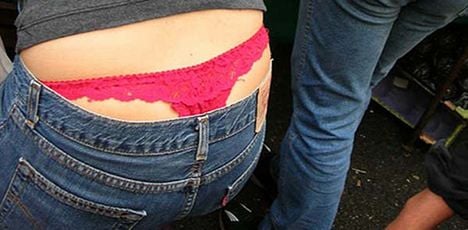“Back in the 1990s, the G-string was the key lingerie item for French women, but it’s star has faded,” said Cecile Guerin, exhibition director for the International Lingerie Fair taking place in Paris next week.
But today only one in four French women – among the world’s top spenders on lingerie – own a G-string, down from 30 percent in 2008, according to a survey commissioned ahead of the fair.
While 45 percent of women still acknowledge that a G-string can be sexy, a quarter see it as “tacky.” Only one in five see it as fashionable and one in 10 as practical.
Sign of the changing times, there were hardly any G-strings among the slinky outfits on display ahead of the fair, intended as a snapshot of industry trends.
“You won’t find any in the women’s magazines either,” said Guerin.
For the bare truth, she said, is that most women’s bodies are “absolutely not” suited to the G-string. “It wedges up into your bottom, and does nothing at all for the figure.”
But the decline of the G-string doesn’t mean Frenchwomen have done a Bridget Jones, the fictional British diarist who eschewed her G-string for a pair of sturdy, stomach-restricting knickers. The modern Frenchwoman’s underwear is still required to be sexy, Guerin says.
In the past decade, Guerin says brands have come a long way with “products that offer the assets of the G-string – ie to be sexy, with no visible panty line – but that are still comfortable.”
“Today you have boxers and body-sculpting knickers that are invisible and seamless with lace and glitter. You feel completely fashionable – and you can still look yourself in the mirror.”
Amandine Calvas, head of marketing for Simone Perele’s glamour lingerie brand Implicite, said his firm has seen a “sharp fall in sales of G-strings.”
For long slim women, said Calvas, better to opt for a boxer short, which have become a “staple” even as the G-string’s appeal wanes.
More voluptuous types can go for tanga briefs – half way between a G-string and pair of high-cut panties – which flatter by elongating the silhouette.
So are the days of G-string numbered?
As more comfortable new styles trickle down to the retail chains, where most women still shop for their lingerie, Guerin predicts the G-string’s share of the market will crumble further.
And while men still give the G-string an overwhelming vote of confidence, with 54 percent saying it ticks the right boxes in the sexiness department.
“That is a question of education,” Guerin said. “They can be made to understand that other things are pretty too.”
“You can be sexy with a bit of humour thrown in,” said Calvas. “You can be sexy with transparencies, with colour, with peep holes, or simply with graphic lines that frame a square of skin.”




 Please whitelist us to continue reading.
Please whitelist us to continue reading.